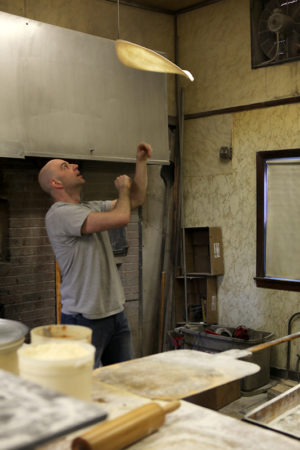Then & Now: Pratt Street Mill Architectural Details, Apizza
Have passed this place for decades and never before noticed the removal of architectural components.
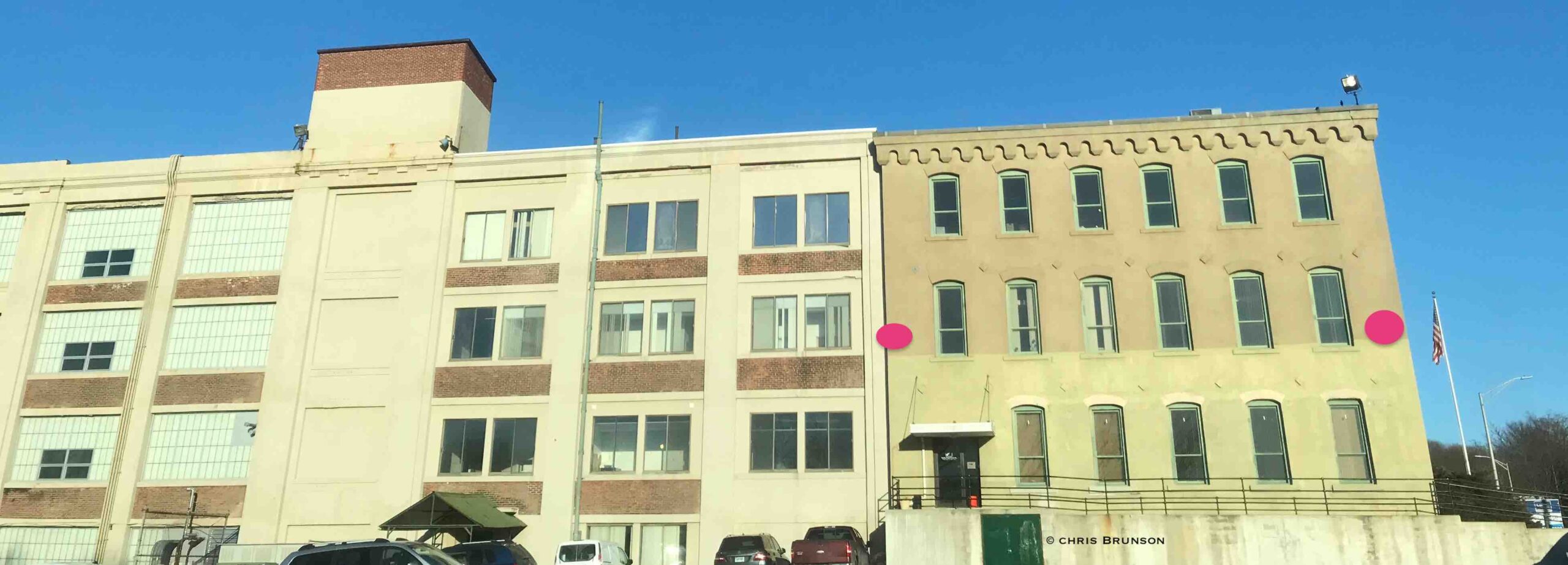
Note the front of the building to the right as seen in this image. The dots are placed where the color shifts and elements have been removed. (See image below.)
Look. Stories and ideas spark on travels, but even familiar places hold discoveries. Look.
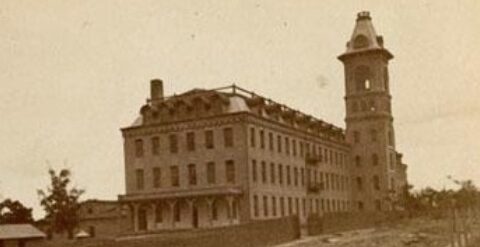
Facing Pratt Street (note the dirt not pavement in front of the building), image detail is cropped; original via eMuseum, Connecticut Museum of Culture and History, linked to collections.
The oldest portion of the fortress-like complex faces Pratt Street and originally was a woolen mill built by Jedediah Wilcox in 1848. Goods made there included carpetbags; later belts, corsets, and hoop skirts.
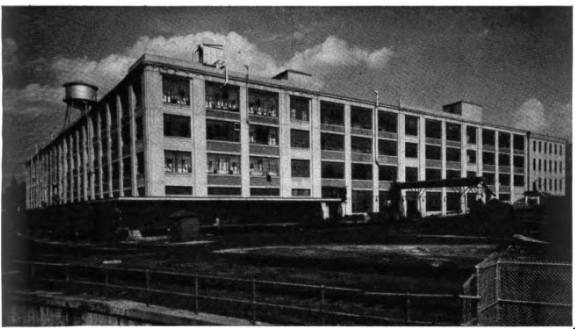
New Departure, Meriden factory location – circa 1944. Ball bearings manufactured here were the ‘tremendous trifle.' This image depicts the original windows; the view appears to be the south face of the building. Upgrades since include new windows for energy efficiency, and solar panels on the roof. Notice to the far right in this image the original part of the structure when it was a woolen mill.
Large things turn on very small objects, decisions. Someone will surely see the potential of this place, how you can go anywhere from here, easily. Rail shipping. A post office just down the street. The idea of a brewery, an indoor thrift and marketplace with lockable stalls for standing vendors. A small eatery on site, coffee, light fare, breakfast. Outdoors, parking, tent set uo. Walkable, bikeable. The trail coming through to Cromwell following old routes.
“It is easy to pretend that nobody can change anything, that society is huge and the individual is less than nothing. But the truth is individuals make the future, and they do it by imagining that things can be different.”
Neil Gaiman
A many-storied building with its own biography; 290 Pratt Street in Meriden, Connecticut. (Part one with more images and context to location, linked here.)
Whispers of human ingenuity, work and manufacturing resonate amid the sounds of production and business happening here and now. From the architecture built for optimum function to open floor space that awaits a new enterprise and another chapter to be written, connections to the nation's and human history remain.

Then and Now: A New Departure ball bearing process production line in the Meriden plant as seen in a company publication at left. Compare to the image at right – what appears to be the same floor space – in 2016. Note the massive support pillars, then and now. TW/MDP
A walk-around that will circle back in time. Office space potential and New Departure ball bearings.
Turns out that working remote for more than a decade was a good decision. That research came to mind recently while thinking of pizza and where to get a medium plain. The travel there and back again brought to light a multitude of ideas. Aviation and ultra precise engine bearings. Innovations used in the automotive industry. Community. Near, far, digital. Twitter. Architecture, adaptive re-use. Food. Gardens. Horses, dogs, wildlife. Books, archives, research. Authors, writers, publishing. Code, data, silos (not the barn type.) Walks and backroads. Science, business. How do I get there? Insurance, people, contacts, resources. Interconnected, one world. A hashtag for #OneHealth.
A global pandemic (remember that a virus never sleeps never tires, always adapts and keeps doing so) led to change in every sector, walk of life, how people get food. But also brought such appreciation for people, places, sharing.
A business neighbor on Pratt Street–from the days of feeding hungry workers from 'round-the-clock shift work–still there making delectable pizza using a 120-year-old coal-fired oven. According to The Little Rendezvous history: “March 27, 1888 – Oven Number 312 to F Duhrkop from the Dutchess Tool Company Matteawan, NY” – for the original bread bakery on site.
Over the years there have been some adaptation and changes – the front entrance on Pratt Street pizza aficionados began life as a market. Now it is the small dining area with tables and chairs to enjoy an in-house pizza – and connects to the oven area where you can pick up a boxed piping hot pizza by walking down a tunnel-like hallway. The Little Rendezvous has a 75-year-plus legacy of its own – order a plain with just grated cheese, a popular selection – to sample why.A tweet heard 'round the world:
Barstool Pizza Review – The Little Rendezvous (Meriden, CT) presented by @rhoback pic.twitter.com/o8KboTuxNg
— Dave Portnoy (@stoolpresidente) June 13, 2023
And now the secret is out.
SUPER LONG WAIT. ALMOST SOLD OUT. WE ARE TRYING OUR BEST.
You can try, but may have to wait to sample the pizza. The very best is order and wait for a piping hot large plain. Then beat feet to get home and savor every single bite. Notice history and remember that life is about learning, sharing, helping. Add to the world, not subtract with choices.
REMINDER: Thursday 9/28 at 6:30
SMOKESTACKS TO MANSIONS: Connecticut's Industrial Age & Gilded Age Families
Come to…Posted by Meriden Historical Society on Thursday, September 14, 2023
Let's shift gears.
Thank you to local & state leaders for attending the groundbreaking for Uncas Leap Heritage Park. The construction will transform the park's outlook, include an outdoor amphitheater, and exhibit for visitors & special events! @SenBlumenthal @LGSusanB @RepJoeCourtney @CathyOsten pic.twitter.com/ccSW3RYiYd
— Mohegan Forward (@MoheganForward) August 15, 2023
What follows is a part of a story that pierces the soul.
Should you notice a pattern of more stories about indigenous history that is all around us, am now (after decades of travel, business, life) seeing, learning, listening, reading more and sharing what is found along the way. This from 1998 via New York Times; a brochure that was handed out by the Mohegan Tribe led to reading more. Unbelievable and hideous,; an eyewitness account.
“On Dec. 14, 1897, Mohegan medicine woman Emma Baker wrote: ‘I was there with my mother in the fall of 1842, where Mr. Osgood's house now stands. Someone had plowed and set out cabbages. Mother said it was the first time that she ever saw it plowed, and she would like to know who did it. We then went across the ravine and on the edge of it someone had made a pit and had a piece of pipe in it for the smoke to escape and they were burning some of the bones and bodies which they had dug up when they had commenced building Goddard Cottage. We then walked across the ravine and there was a large plain lot which had not been built on. She said that the burial ground went beyond that and that they had begun to build on some of the land.'”
By Sam Libby via New York Times; see the article in its original context from March 8, 1998, Section CN, Page 14.
Have thought about this desecration since. Words bring the horror of this to light.
Worth repeating.
“On Nov. 4, [2021] the papers of Fidelia ‘Flying Bird' Fielding, who died in 1908, were transferred from Cornell University Library to the Mohegan Tribe. Mohegan Tribal Historic Preservation Officer James Quinn traveled from Uncasville, Connecticut, to Cornell’s Ithaca campus to receive the rare manuscripts from Gerald R. Beasley, the Carl A. Kroch University Librarian. Beasley was accompanied by Tamar Evangelestia-Dougherty, associate university librarian; and Anne Sauer, the Stephen E. and Evalyn Edwards Milman Director of the library’s Division of Rare and Manuscript Collections.” From Cornell Chronicle; because of this important story, the following image is linked to the site. Seeing the showcase at the visitor center exhibit area At the Tantaquidgeon Museum event literally gave goosebumps. Simply in awe.
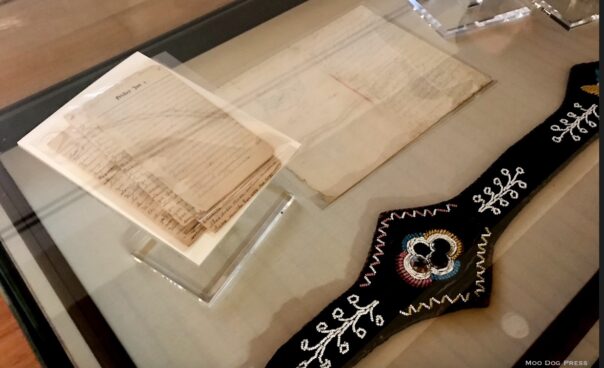
“On Nov. 4, [2021] the papers of Fidelia ‘Flying Bird' Fielding, who died in 1908, were transferred from Cornell University Library to the Mohegan Tribe. Mohegan Tribal Historic Preservation Officer James Quinn traveled from Uncasville, Connecticut, to Cornell’s Ithaca campus to receive the rare manuscripts from Gerald R. Beasley, the Carl A. Kroch University Librarian. Beasley was accompanied by Tamar Evangelestia-Dougherty, associate university librarian; and Anne Sauer, the Stephen E. and Evalyn Edwards Milman Director of the library’s Division of Rare and Manuscript Collections.” From Cornell Chronicle; because of this important story, have linked this image to that site.
More noteworthy words, accomplishments. News. Nature. Books.
Coming up September 21st is our Wetu Book Club! Join the Executive Director of the Pequot Museum for an in-depth discussion about Diane Wilson's novel, "The Seed Keeper!" Available for sale in the Museum Store!
Book your spot! https://t.co/8Dzd16J7MY pic.twitter.com/HwP0Uol4rJ
— Pequot Museum (@pequotmuseum) September 1, 2023
One of my fears is draws where I don't know how deep the holes are, and I feel very taken care of by this horse. (Draw is far ahead, hardly visible in this photo.) thanks, Grumbles. pic.twitter.com/epEFbAuinM
— A Smith Muise (@amysmithmuise) September 3, 2023
Note: Portions of this story have been published previously. For adaptive re-use of industrial site for urban agriculture across the globe, visit The LafargeHolcim Foundation which has the mission to “select and support initiatives that combine sustainable construction solutions with architectural excellence.” Part one of the story, linked here. This story was updated Sept. 16, 2023.

